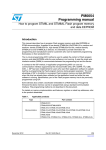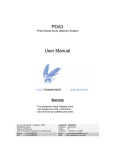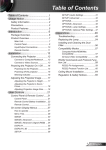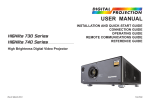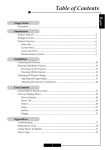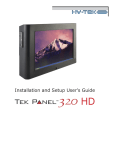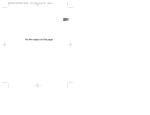Download Englische Übersetzung
Transcript
Information on DW-TV 16:9 widescreen broadcasting Why is transmission being changed to 16:9 widescreen format? What is anamorphic distortion of a television picture? Why are anamorphically distorted television pictures broadcast? What does letterboxing mean? What does Pan & Scan mean? How is the screen format identified when transmitted via satellite? What does WSS stand for? How is the screen format identified when using a SCART connector? FAQs How do I set my appliance to enable automatic screen size adjustment? Viewer’s Information - TV with 4:3 screen format The program is broadcast in 16:9 format; the picture on my 4:3 screen is vertically distorted. How can I solve the problem? My television has a 4:3 screen format; when the program is broadcast in 16:9 format some picture content is cut off on both sides. How can I solve the problem? My television has a 4:3 screen format; I would like to watch 16:9 screen broadcasts in letterbox format. How can I solve the problem? Viewer’s information - TV with 16:9 screen format The program is broadcast in 16:9 widescreen format; even though I have a 16:9 flat screen television, my picture is vertically distorted and has black bars on both sides. How can I solve the problem? A program broadcast in 4:3 format is horizontally distorted on my 16:9 flat screen television. How can I solve the problem? My television has a 16:9 widescreen format; if the program is broadcast in 4:3 format, some picture content is cut off at the top and bottom? How can I solve the problem? I receive DW programs via satellite or via cable; even though I have a 16:9 flat screen television, the broadcast in 16:9 format has black bars surrounding the picture. How can I solve the problem? 3 Why is transmission being changed to 16:9 widescreen format? Today the majority of television sets on the market have 16:9 screen format (also known as widescreen format, because the picture is wider than pictures in 4:3 format). One of the reasons why 16:9 widescreen format has been introduced is because it corresponds more closely to the characteristics of the human field of vision and visual habits than 4:3 format. Widescreen format takes into account the fact that human peripheral vision is more pronounced on the horizontal axis than on the vertical axis The aspect ratio of a widescreen format is 1.78; the ratio between the horizontal and vertical angle of vision of a motionless human eye is 1.64; from this it can be seen that the aspect ratio of 16:9 format is closer to that of the human eye than that of 4:3 format. In addition to the above-mentioned technical and physiological reasons, there are also other reasons which favor 16:9 widescreen broadcasting. Artistic and picture-making possibilities should be considered, such as the possibility to move an important feature in the picture away from the centre to create more overview or the possibility of improved alignment of fore- and background elements - resulting in a better 3D-effect and a more naturally proportioned picture. Other arguments in favor of widescreen format are technological innovations and prevailing market conditions. Screen technology is advancing fast and new flat screen televisions (plasma or LCD) are now only available in 16:9 format. The 4:3 screen format used previously is definitely on the way out. The above-mentioned reasons speak for a change-over to 16:9 widescreen format. Deutsche Welle is adapting its productions step-by-step to keep up with technological advancements in this field. back to home 4 What is anamorphic distortion of a television picture? Anamorphic distortion is when only one axis of a picture is distorted. It is used when 16:9 television productions have to be viewed on a 4:3 screen. The horizontal axis is “squeezed” resulting in a vertical distortion of the picture. The following images show an example of anamorphic distortion. Here the anamorphic distortion has reduced the picture width from16 to 12 leading to an aspect ratio of 12 : 9 = 4 : 3 This means that the anamorphically distorted picture can now be shown on a 4:3 screen without any loss of content. 5 Anamorphic distortion can be created by a special lens in the camera or electronically with an image processor. back to home Why is an anamorphically distorted television picture broadcast? Television productions in a new screen format mean that viewers require a television set or a flat screen television which is capable of showing this format. Those who have a 4:3 screen television would have to buy a widescreen television. However, Deutsche Welle has decided to create a ‘bridge’ between the previously used 4:3 screen format and the new widescreen format by “squeezing” (anamorphic distortion) the original 16:9 production. This means that the 16:9 aspect ratio has been converted to the previously used 4:3 aspect ratio and no change is required in the processing of broadcasting signals by television stations or in the TV sets. Anamorphic distortion permits broadcasting in 16:9 widescreen format using current television standards – CCIR PAL, CCIR NTSC. back to home 6 What does letterboxing mean? One of the disadvantages of anamorphic distortion is that when viewed on a 4:3 screen, the picture is vertically distorted; this can be compensated by reducing the height of the television picture. The picture has to be reduced by a factor of 0.75 in order to maintain the original image proportions. This conversion is done automatically by an image editor in the set-top box. Scan lines are removed to reduce the height of the picture. The number of scan lines that need to be removed depends on the television standard used. CCIR PAL Norm CCIR NTSC Norm 576 visible scan lines 576 scan lines x 0.75 = 435 scan lines 576 – 432 = 144 144 scan lines need to be removed. 480 visible scan lines 480 scan lines x 0.75 = 360 scan lines 480 – 360 = 120 120 scan lines need to be removed The scan lines are removed and replaced with scan lines that are black in content – these lines are divided into two and one half is placed at the top of the screen and the other half at the bottom. The result is a television picture with wide black bars at the top and bottom edge. It looks as though you are looking at the picture through an opened letterbox – hence the name letterboxing. back to home 7 What does Pan & Scan mean? Basically, a program that is transmitted in 16:9 format is too wide for 4:3 screen format. Pan & Scan is another method (in addition to letterboxing) of adjusting widescreen film images so that they can be shown on a 4:3 aspect ratio television screen. The original 16:9 image is cropped to fit a 4:3 screen, a simplified implementation of the Pan & Scan method is to crop the sides of the image to focus on the center of the original composition. The Pan & Scan technique is more complex than letterboxing because the decision as to which part of the image should be cropped depends on the original screen content. During the Pan & Scan process, the operator selects the parts of the original filmed composition that seem to be significant. The information as to how an image should be cropped has to be sent along with the original digital television signal. The actual cropping of the image then takes place in the set-top box. 8 A number of set-top boxes support Pan & Scan. If you have your set-top box set to Pan & Scan to reduce the original image for a 4:3 screen, you will always only see part of the original scene transmitted on 16:9 widescreen. If the information for the cropped image is not sent with the original signal, then the centre of the image is used; in this case the picture content on both sides of the original image is lost. back to home 9 How is screen format identified when transmitted via satellite? At present, Deutsche Welle transmits in both 4:3 format and 16:9 widescreen format, which means that the format needs to be identified when transmitted. The format information is embedded in the digital MPEG-2 transport stream. MPEG-2 is a process which reduces the vast amounts of data required for a television transmission to an amount that can be transmitted via satellite. The playout in the Deutsche Welle broadcasting center in Berlin creates the MPEG-2 transport stream. An MPEG-2 transport stream is made up of several audio and video streams which are hierarchically combined. Each stream has a header and the aspect ratio flag carried in the sequence header. 4:3 16:9 format = widescreen format = 0010 0011 The set-top box (satellite receiver) recognizes the digital aspect ratio flag . In theory the set-top box then automatically adjusts the incoming signal format to fit the television screen. Unfortunately not all set-top boxes, available on the market, can interpret the data-bit combination; i.e. the television set or flat screen television is not able to adjust the screen format accordingly. as a result of the philosophy of some manufacturers, there are several television sets and flat screen televisions on the market, which do not provide their users with an automatic screen format adjustment facility. back to home 10 What does WSS stand for? Deutsche Welle programs can only be received via a set-top box (DVB-S or DVB-C). The set-top box converts the digital signal into a format which can be viewed and heard on your TV set or flat screen TV. Aspect ratio flag embedded in the MPEG-2 transport stream is recognized by the set-top box. The set-top box then creates a WSS signal. WSS stands for ‘widescreen signaling’; it is a squarewave signal with a binary-coded data signal containing the information of the aspect ratio flag carried in the MPEG sequence header. How the set-top box integrates the WSS signal depends on the television standard used. CCIR PAL norm - the first part of line 23 is used to transmit the WWS signal (independent of image signal type) CCIR NTSC norm – line 20 and 283 are used to transmit the WWS signal (independent of image signal type) The integration of the WSS signal for the different image signal types, in the above mentioned lines, is as follows: CVBS signal (composite video signal) – encoded as one signal. The WSS is integrated in the above mentioned lines. YUV signal (component video signal) – The WSS is only integrated in the Y signal (brightness/luminance signal) RGB signal – The WSS is integrated in the R, G and B signals. 11 Unfortunately, not all set-top boxes available on the market can interpret the data-bit combination of the aspect ratio flag carried in the MPEG sequence header ; i.e. the television set or flat screen television is not able to adjust the screen format automatically back to home How is the screen format identified when using a SCART connector? When a SCART cable is used to connect the set-top box to the TV set or flat screen television the image format is identified with the help of a voltage switch on pin 8 of the SCART plug. The voltage is changed according to image format. 6V 12 V = = 16:9 widescreen format / AV mode 4:3 format / AV mode The voltage switch is produced by the set-top box and the TV set or flat screen television recognizes the voltage on pin 8 of the SCART plug and adjusts the image format accordingly. Some set-top boxes also embed a WSS signal in the image signal in addition to the voltage switch. back to home 12 How do I set my appliance to enable automatic screen size adjustment? Your set-top box or TV appliance should have the following technical requirements to enable automatic image format adjustment; unfortunately not all appliances meet these requirements. Technical requirements and appliance settings ... set-top box ... TV set / flat screen TV 1. The set-top box must have the facility to 1. The TV set or flat screen TV must have recognize the aspect ratio flag carried in an automatic screen size adjustment the MPEG sequence header facility 2. If the set-top box has the facility to 2. The TV set or flat screen TV has to recognize the aspect ratio flag carried in recognize either the WSS-signal or the the MPEG sequence header , the voltage on pin 8 on the SCART plug. format of the connected TV-set or flat 3. The automatic screen size adjustment screen TV has to be entered into the facility has to be activated on the TV set set-top box or flat screen TV. 3. The set-top box compares the incoming image format with that of the connected appliance. 4. The box then produces an appropriate WSS-signal or produces the correct voltage for pin 8 on the SCART plug 13 The following flow chart shows the interaction between the technical requirements and settings for automatic screen size adjustment. Unfortunately, the control elements and corresponding terminology for set-top boxes and TV appliances are not standardized. If you are in doubt, please refer to the appropriate user’s manual or contact your specialist dealer. If your appliances have the facility for automatic image format identification, you can program each appliance using the navigation menu to automatically adjust the image size. Please refer to the appropriate user’s manual for details. Manufacturers have different ideas as to the ideal format for showing 4:3 images on widescreen appliances. Unfortunately, this means that automatic adjustment produces different image sizes on screens produced by different manufacturers. 14 The following chart shows possible image types when automatic image format adjustment is used: A TV picture in 4:3 format is shown as a pillar box image. The proportions are identical to the original image. Disadvantage Wide black bars appear on both sides of the picture. A TV picture in 4:3 format is horizontally ‘stretched’ to fill out the TV screen. Disadvantage The proportions are not identical to the original picture, resulting in a horizontal distortion of the picture. A TV picture in 4:3 format is enlarged horizontally and vertically to fit the width of the TV screen Disadvantage The proportions are identical to the original picture, but as a result the picture is now too tall for the screen and the top and bottom parts of the picture are cut off. back to home 15 A television program sent in 16:9 widescreen format is vertically distorted on my 4:3 television screen. How can I solve the problem? You have a television with a 4:3 screen format and receive DW TV programs on a set-top box via satellite. At present, DW-TV transmits its programs in 16:9 widescreen format with anamorphic distortion. If your set-top box is not correctly adjusted to the 4:3 format of your television screen, you will see a picture with anamorphic distortion, i.e., your television picture is vertically distorted. To solve the problem: A number of set-top boxes have the facility in their menu to adjust the format of the connected TV appliance using the remote control. Choose the menu item ‘letterbox format’. Please refer to the user’s manual for detailed menu navigation. Unfortunately there is no standardization for menu terminology or navigation. The following table shows the most commonly used terminology for navigation menus. Menu item aspect ratio aspect mode picture format display format screen format screen mode TV mode TV type Options 4:3 4:3 letter box 4:3 letterbox letterbox letterbox format After you have carried out the necessary adjustments, the set-top box will automatically produce a 16:9 widescreen format as a letterbox picture on your TV screen. Letterboxing is the optimal format for a 16:9 widescreen transmission on a 4:3 TV screen. Your set-top box settings are now correct. back to home 16 My television has a 4:3 screen format; when the program is broadcast in 16:9 format some picture content is cut off on both sides. How can I solve the problem? You have a television with a 4:3 screen format and receive DW-TV programs through a set-top box via satellite. At present, DW-TV transmits its programs in 16:9 widescreen format with anamorphic distortion. If picture content is missing on both sides of your screen, this could mean that your set-top box converts to a 4:3 format using Pan & Scan. Your set-top box is not optimally adjusted to your TV appliance. To solve the problem: A number of set-top boxes have the facility in their menu to adjust the format of the connected TV appliance using the remote control Choose the menu item letterbox format. Please refer to the user’s manual for detailed menu navigation. Letterboxing is the optimal format for a 16:9 widescreen transmission on a 4:3 TV screen. Unfortunately there is no standardization for menu terminology or navigation. The following table shows the most commonly used terminology for navigation menus. Menu item aspect ratio aspect mode picture format display format screen format screen mode TV mode TV type Options 4:3 4:3 letter box 4:3 letterbox letterbox letterbox format back to home 17 My television has a 4:3 screen format; I would like to watch 16:9 screen broadcasts in letterbox format. How can I solve the problem? You have a television with a 4:3 screen format and receive DW-TV programs on a set-top box via satellite. At present, DW-TV transmits its programs in 16:9 widescreen format with anamorphic distortion. The picture of a program broadcast in 16:9 format is either vertically distorted or picture content may be missing on both sides. Your set-top box is not optimally adjusted to your TV appliance. To solve the problem: A number of set-top boxes have the facility in their menu to adjust the format of the connected TV-appliance using the remote control Choose the menu item letterbox format. Please refer to the user’s manual for detailed menu navigation. Letterboxing is the optimal format for a 16:9 widescreen transmission on a 4:3 TV screen. Unfortunately, there is no standardization for menu terminology or navigation. The following table shows the most commonly used terminology for navigation menus. Menu item aspect ratio aspect mode picture format display format screen format screen mode TV mode TV type Options 4:3 4:3 letter box 4:3 letterbox letterbox letterbox format back to home 18 The program broadcast in 16:9 widescreen format; even though I have a 16:9 flat screen television my picture is vertically distorted and has black bars on both sides (pillarbox format). How can I solve the problem? You have a television with a 16:9 screen format and receive DW-TV programs on a set-top box via satellite. If your set-top box is not optimally adjusted to the 16:9 widescreen format of your flat screen TV, then the 16:9 format picture will be anamorphically distorted; i.e. the picture is vertically distorted. Pillarboxing is the term used to describe the picture when a 4:3 format picture is shown on a flat screen with 16:9 widescreen format. How can I solve the problem? 1. Solution Flat screen TVs with a 16:9 widescreen format have the facility, in the navigation menu, to increase picture width to fill the screen. Unfortunately, there is no standardization in flat screen menu navigation. Please refer to the user’s manual for detailed menu navigation. The following table shows the most commonly used terminology for navigation menus. Menu item display mode aspect picture format screen format screen mode screen size Options 16:9 16:9 mode wide full fullscreen mode 2. Solution Set-top boxes and flat screen TVs can be programmed (if they meet the technical requirements for automatic format adjustment) to automatically convert the broadcast picture format. The required settings for automatic format adjustment are described under the section automatic format adjustment. back to home 19 A program broadcast in 4:3 format is horizontally distorted on my 16:9 flat screen television. How can I solve the problem? The automatic format adjustment option on your set-top box and flat screen TV is probably activated. If a program is broadcast in 4:3 format, the automatic adjustment can lead to a 4:3 picture being shown in what is known as the fullscreen mode - the electronics in the flat screen TV ‘stretch’ the picture horizontally without changing the height of the picture. How can I solve the problem? The screen mode on your flat screen TV has to be altered using the navigation menu. Unfortunately, there is no standardization for flat screen menu navigation. Please refer to the user’s manual for detailed menu navigation. The following table shows the most commonly used terminology for navigation menus. Menu item display mode aspect picture format screen format screen mode screen size Options 4:3 4:3 mode 4:3 pillar box pillarbox back to home 20 My television has a 16:9 widescreen format; if the program is broadcast in 4:3 format, some picture content is cut off at the top and bottom? How can I solve the problem? The set-top box and flat screen TV may be set to automatic format adjustment. As a result of this, the picture size of a program broadcast in 4:3 format displayed on a 16:9 flat screen may be enlarged (zoom) until the width of the picture is the same size as the 16:9 screen. As the enlargement (zoom) doesn’t alter the picture proportions, the height of the picture increases accordingly and the picture content at the top and bottom of the picture is lost. How can I solve the problem? If you would like to change your picture format you need to change your viewing mode in the navigation menu on your flat screen TV. Unfortunately, there is no standardization for flat screen menu navigation. Please refer to the user’s manual for detailed menu navigation. The following table shows the most commonly used terminology for navigation menus. Menu item display mode aspect picture format screen format screen mode screen size Options 4:3 4:3 mode 4:3 pillar box pillar box back to home 21 I receive DW programs via satellite; even though I have a 16:9 flat screen television the broadcast in 16:9 format has black bars surrounding the picture. How can I solve the problem? This is caused by an incoming picture in letterbox format being shown on a 16:9 screen which is in 4:3 mode. Letterboxing is the cause of the black bars at the top and bottom of the picture and the 4:3 (pillarbox) mode is responsible for the black bars at the side of the picture How can I solve the problem? A number of set-top boxes have the facility to alter the screen format of the connected TV appliance using the remote control and the navigation menu. It is probable that the screen format of the connected TV appliance has been incorrectly set to 4:3 format instead of a 16:9 format. If the set-top box receives a program in 16:9 widescreen format, it automatically produces a picture signal in letterbox format; letterboxing is the optimal viewing format for a 16:9 widescreen picture on a TV set with a 4:3 screen. Use the navigation of your set-top box to change the format of the connected TV appliance to 16:9 format. Unfortunately, there is no standardization for menu navigation. Please refer to the user’s manual for detailed menu navigation. The following table shows the most commonly used terminology for navigation menus. Menu item aspect ratio aspect mode display display mode picture format screen format screen mode TV mode Options 16:9 16:9 mode Full wide 22 TV type If the problem has not been solved using the remote control of the set-top box, then it may be necessary to change the display mode on the connected screen using the flat screen TV’s navigation menu. Unfortunately, there is no standardization for flat screen menu navigation. Please refer to the user’s manual for detailed menu navigation. The following table shows the most commonly used terminology for navigation menus. Menu item aspect display picture format screen format screen size Options 16:9 16:9 mode Full wide back to home 23 I receive DW programs via cable; although I have a 16:9 flat screen television the broadcast in 16:9 format has black bars surrounding the picture. How can I solve the problem? This type of picture is caused by an incoming picture in letterbox format being shown on a 16:9 screen which is in 4:3 mode. Letterboxing is the cause of the black bars at the top and bottom of the picture and the 4:3 (pillarbox) mode is responsible for the black bars at the side of the picture How can I solve the problem? Cable providers often letterbox programs received in 16:9 widescreen format. If your appliance does not have an automatic format adjustment facility, the display format needs to be altered using the flat screen TV’s navigation menu Unfortunately, there is no standardization for flat screen menu navigation. Please refer to the user’s manual for detailed menu navigation. The following table shows the most commonly used terminology for navigation menus. Menu item aspect display mode picture format screen format screen size Options 16:9 16:9 mode full wide back to home 24
























